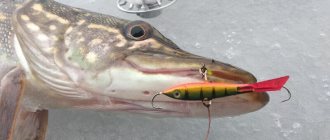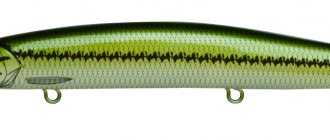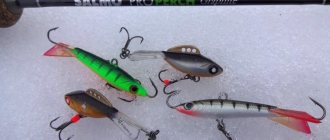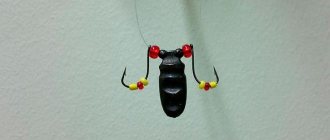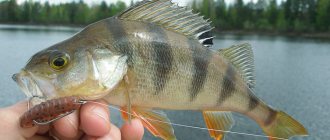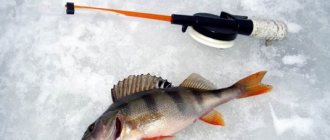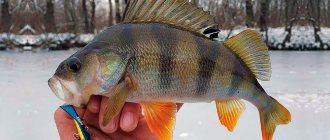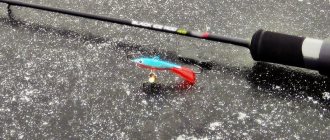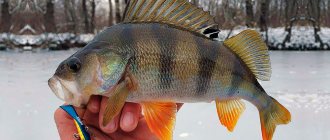What should a balancer be like for a perch?
A balancer for perch is selected according to certain criteria that facilitate the purchase of a working tool without practical experiments in its use, which is sometimes difficult to do outside a reservoir. What you should know about the balancer is that it is a winter artificial bait used for vertical trolling. It is worth noting that this is a horizontal type spinner that resembles a small fish in appearance. As a rule, a winter lure for perch of this type is equipped with two single stationary hooks from the head and tail of the bait. And also a hanging tee in the abdomen area of the simulator in the central part of the body. More often, spoons are made of plastic or metal, covering the material with waterproof paints, highlighting the point of attack. Usually these are holographic eyes of the spinner.
What parameters are used to select a balancer for perch?
When looking to purchase a perch balancer, the fisherman needs to understand what properties the fishing tool has and what to look for first. Among the most important selection criteria are the following parameters that characterize the perch orientation of the product:
- weight and dimensions of the simulator;
- type of balancer and shape;
- coloring and tuning of artificial bait.
In the continuation of the article, we will dwell on the consideration of each selected criterion from a detailed perspective.
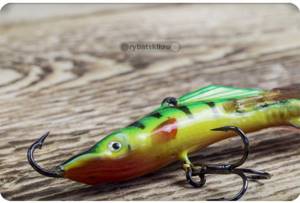
Photo of a balancer with a tee without a drop
How to choose a balancer?
Even experienced fishermen can get lost in today's variety of balancers. However, there are classic options that work year after year, in completely different places. To understand which balancer to take with you on a fishing trip, you need to know such features of the reservoir as depth, presence of current, water transparency and the nature of the bottom. Let's try to give advice on choosing balancers for fishing in the Moscow region, summarizing the characteristics of reservoirs adjacent to Moscow. As a rule, these are reservoirs with a fishing depth of up to 10 meters. We will select balancers for different fish:
How to choose a balancer for perch?
Perch, like any predator, loves to feast on fry, especially when they look wounded, here instinct comes into play... Perch, seeing the balancer making a “figure eight”, can no longer do anything else but try it on the tooth, thereby getting hooked! But it’s important to choose what kind of fry imitation the perch likes in a particular place. If the reservoir is unfamiliar, then you can start searching for perch under the shore, at depths of up to 1.5 meters, then the following models and colors will be especially effective:
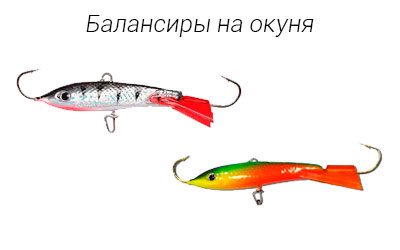
Buy Lucky John balancers for perch
Usually, the smallest balancers are chosen for catching perch; often, the perch prefers larger options, 4, 5 and even 6 cm long, to small balancers, while the size of the perch can be slightly larger than the balancer itself.
Balancers for catching perch at a depth of up to 10 meters:

Buy balancers for perch fishing
As for the color of the balancer for perch, the most popular are:
| See color 26RT in the catalog |
| See color 12HRT in the catalog |
| See catalog color 20 |
| See color 24 in the catalog |
| See color 36RT in the catalog |
How to choose a balancer for pike perch?
Pike perch belongs to the order of perch, but catching it on a balance beam is much more difficult; pike perch really loves flooded trees and snags, which in turn is afraid of balance beams. It is advisable to scout the bottom or stock up on hooks that can help you get the balancer, but not in 100% of cases. Regarding the balancers themselves, the pike perch is used to staying at depth, and very small fish at depth are not frequent guests, so in order not to put the pike perch into a stupor, you need to choose larger balancers, usually from 5 cm:

Buy Lucky John balusters for pike perch
Pliant from Lucky John are very catchy balancers for pike perch; they are distinguished by natural colors.
Therefore, according to the same principle, as a rule, balancers of other series are chosen; the most catchy colors are:
| See color 13H in the catalog |
| See color 15H in the catalog |
| See color 16H in the catalog |
| See color 03H in the catalog |
| See color 12HRT in the catalog |
How to choose a balancer for pike?
When fishing for pike, you should not reduce the size of the balancers; choose balancers that are at least 5-6 cm, and preferably around 7 or more. At great depths, “pot-bellied” models, such as Baltic or Mebaru, perform well - in shallow water, FIN balancers will work great - in cloudy weather, usually, balancers with “acid” paints work better, in clear weather - natural colors, despite the fact that the water transparent.
Balancers for pike fishing:

Buy balancers for pike fishing
Rating of the 10 most catchy perch balancers
In this section of the article, we will consider the rating of balancers for perch, which have long been tested by fishing practice and the prospect of application for this small predator. Purchasing the presented models to add to your arsenal will help cover most of the fishing conditions that arise, getting the result expected from the trophy.
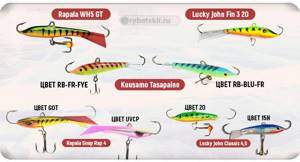
The best models with flowers
- The leader is the model from the Finnish Rapala WH5 in GT color. This imitation of nine grams and 5 centimeters with a tee equipped with a reflective droplet, which acts as an attack point, almost never leaves the angler without a catch.
- Lucky John Fin 3 in color according to the manufacturer's classification at number 20, takes second place. This is one of the smallest tools for medium and small perch, which is the main object of hunting during the freeze-up period.
- Third position goes to the Japanese Kuusamo Tasapaino in the rb-fr-fye and rb-blu-fr colors. We recommend equipping your arsenal with sizes of 50, 60 and 70 mm, allowing you to hunt even large perches.
- It would be a good idea to add Rapala Snap Rap 4 to the collection in GOT and UVCP colors. Experienced fans of ice fishing for perch appreciate these models for the originality and originality of the game.
- The top five is rounded out by another representative from Lucky John Classic 4.5 in colors 15H and 20. The calm and sweeping game attracts passive perch to the hole during periods of deep winter.
- The creative model Lucky John Pro Series Mebaru 37 in colors 201 and 107 is used when perch activity is low. The design of the simulator will allow, by changing the attachment point, to produce a game with a different range.
- Number seven is Rapala Jigging Rap 5 in BYR, BSR colors. The model is endowed with the qualities of a stable and active game, excited even by short pulls with the tip of the fishing rod, attracting a passive predator under the hole.
- Eighth we put the Sprut Hijaro 50 tool, painted in types HP-UV, 50 WB. The unusual structure of the body with shallow wave unevenness of the surface, in addition to the trajectories of movements themselves, can produce vibrations that additionally encourage the perch to attack.
- In the ranking of the best balancers for perch, ninth place was taken by another representative from Lucky John Classic 3 in color variations 19 and 13H. The model is mainly used for fishing deep-water areas on rivers with moderate currents, where croakers are targeted for fishing.
- The deep-sea balancer Lucky John Baltic 4, offered to the buyer in color 201, 13H, closes the list. The manufacturer's innovation in the form of applying corrugations to the body of the bait made it possible to obtain fishing advantages over similar types of bait from other brands of passive perch.
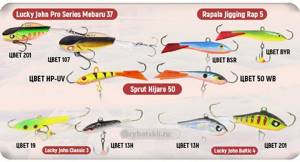
The best balancers for perch fishing: top 10
To choose the right balancer for perch, you should have at least some information about what types of balancers there are, their models and their manufacturers. This is necessary in order to navigate the wide variety of these baits. Among the huge variety there are the most catchy ones. Below are models of catchable balancers for perch.
Working balancers for perch: Fishing with Normund #33
Aqua Jig-2 Trapper
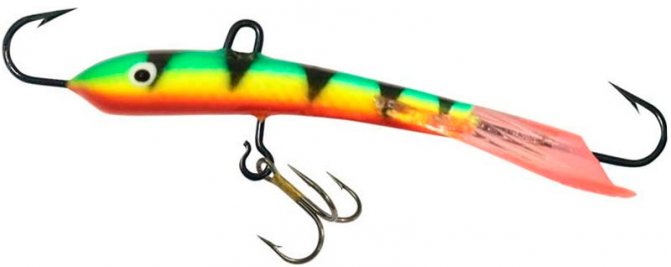
The bait is equipped with a tee No. 10 and can work at a depth of 8 meters. There is a holographic drop on the hook, which makes the bait more attractive. If purchased, you should pay attention to the back hook, which may not be strong, as a result of which it quickly deforms when in contact with ice. You can buy it for about 90 rubles.
Aqua Jig-1 Classic
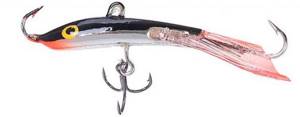
The cost of this bait is also 90 rubles, but it is a more universal balancer, with a diving depth of up to 5 meters. This bait is suitable for catching perch in both winter and summer. In addition to perch, pike and burbot are caught on this balancer. According to some statements, the bait has one drawback - the tail often breaks.
Nils Master Jigger-2

This is a balancer that successfully catches fish at a depth of up to 14 meters. 7 cm specimens are more suitable for catching perch. The remaining sizes are designed for catching other predatory fish.
Among these models, defective products are possible, therefore, when purchasing, you need to study the bait very carefully. The cost of such a product is 400-450 rubles.
Kuusamo Tasapaino-75
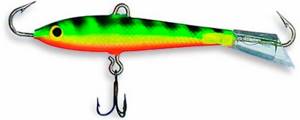
It is a bait from a Finnish manufacturer, which is designed purely for perch fishing. Although many note that burbot also bites on this balancer. Equipped with a tee No. 12. This model costs around 550 rubles.
Salmo Lucky John 6
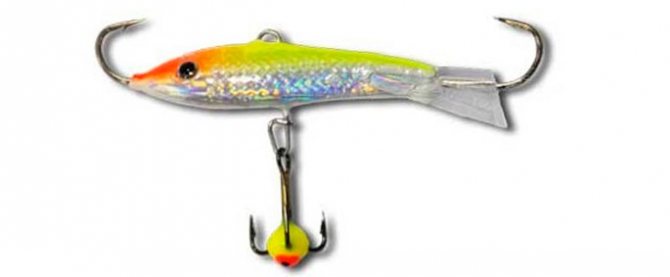
The balancer is designed for perch fishing and does its job perfectly in December or January. It is not intended for catching large specimens, but it is also interested in other predatory fish, such as pike perch or pike. The rear hook of this model is powerful enough to cope with any task. Can fish at depths of up to 6 meters. Such bait costs about 250-300 rubles.
Salmo Lucky John 5

Designed for fishing at depths of up to 14 meters. Quite often you come across perches up to 1.5 kg in size. In addition to perch, you can also catch other predatory fish with this bait. The approximate cost is in the range of 250-270 rubles.
Karismax Koko 3
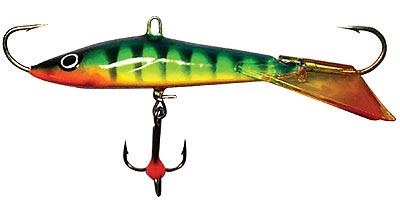
The balancer is equipped with a #10 tee, as well as a colored drop. Only high-quality materials were used in production. Can work on both perch and other predatory fish. Working depth – up to 6 meters. The estimated cost is around 800 rubles, which is the only drawback of this model.
Rapala W3

Works well for medium-sized perch, weighing up to 0.7 kg. It works at a depth of about 6 meters. When purchasing, you need to be quite careful, as there are defective products. The bait is valued at 380 rubles.
Rapala W7

This is a winter balancer that is larger in size compared to the Rapala W3. At the same time, the side hooks are smaller. You can buy a similar product for 400 rubles.
Ecotechnology E35 PL
This is a domestic universal type balancer designed for catching perches of any size. In addition to perch, other predatory fish are also interested in them.
Compared to imported samples, this balancer is cheaper and can be purchased for 100 rubles.
Balancers for perch. Search balancers video
How to rig a fishing rod
I catch perch in winter using a balance rod using a spinning rod, only of a much smaller size than a fishing rod used in open water. For trolling, a rigid form up to 50 cm long is used, with guide rings and a handle with the ability to mount a reel. In conditions of low temperatures and rapid supply of bait to depths, the use of medium-sized inertial reels filled with monofilament fishing line no thicker than 0.2 mm is justified.
Perch can be caught on a balance beam without setting a leash.
The bait is attached directly to the fishing line or carabiners and miniature fasteners are used for quick changes. The supply of fishing line should exceed the parameters of the depth level being fished at least twice.
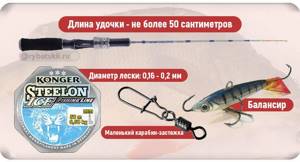
Elements of equipment for a winter spinning rod for catching perch from ice
Rapala balancers for perch. Review of the 5 best perch colors and patterns.
The balancer is an excellent bait for catching winter perch, as any avid angler will confirm. The balancer imitates a small feeding fish. It has three hooks - one in front, one in back and a tee at the bottom, so derailment is practically impossible. Playing with a balance beam is quite easy; alternating simple swings and pauses brings excellent results! The game of the balancer can be described as simple, very realistic. Balancers are distinguished between unfolding and tumbling; both options are suitable for perch. The balancer almost always has a plastic tail, which acts as a stabilizer.
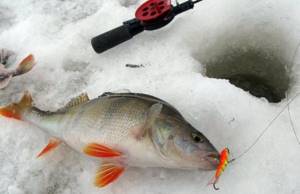
And so, after a rough understanding of what a balancer is, you should move on to making a choice. At the moment, you can find a variety of balancers on sale. There are some expensive ones and some not so expensive ones. The leader in the production of balancers is rightfully the American-Finnish company Rapala. Balancers from this brand have been successfully used by our fishermen for decades. It is worth noting that Rapala balancers are among the most expensive on the world fishing market, but their amazing catchability overshadows the high price.
All models from the Rapala catalog are suitable for perch fishing, but the best results are shown by the legendary Jigging Rap and Snap Rap. The Rapala Jigging Rap balancer is not only a perch classic. All predatory fish bite perfectly on this balancer. This balancer is universal, simple and extremely effective. Another popular model called the Snap Rap also works great on the striped robber. The strikingly naturalistic action of the Snap Rap balancer makes the perch greedily pounce on the bait.
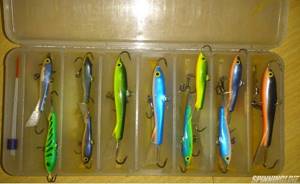
As for colors and sizes, serious disputes flare up between fishermen on this matter. Some people think that the smallest balancer would be ideal, while others, on the contrary, prefer to use large baits. In principle, all colors available in the Rapala catalog are suitable for perch fishing. But there are more popular and well-known ones - various variations of acid green and natural shades. According to reviews from domestic anglers, the best colors for catching perch are: BST, FP, GBT, GLP and PSH. Balancers in length from 3 to 6 cm are considered the most universal.
The 4River store team has its own view on this issue.
Top 5 balancers for perch fishing from Rapala according to the 4River store!
- Jigging Rap 3 cm is a small balancer for catching small and cautious perch at shallow depths.
- Jigging Rap 5 cm is a classic universal option. Well seduces trophy perch.
- Snap Rap 4 cm is a good balancer for catching perch and is quite versatile. Suitable for shallow places and sluggish fish.
- Snap Rap 6 cm - ideal for catching large perch. Convenient for deep-sea fishing.
- Flat Jig 4 cm is a model created specifically for fishing in deep water and strong currents. With a length of 4 cm, it weighs 16 grams!
Top 5 perch flowers according to the 4River store!
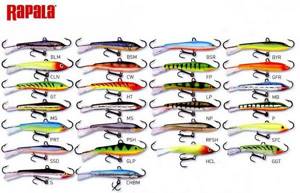
- BSR – nothing to say about this color, a true classic. Blue back, whitish body and orange belly.
- CLN is the so-called “clown”. Many experienced fishermen know about this color, but beginners often avoid it, but in vain!
- FP is another well-known color, an acidic yellow-green. Works well in muddy water.
- MS is a universal color. Suitable for both perch and pike perch. Has proven itself on the positive side when catching sluggish fish.
- RFSH is a neutral color. Works well in sunny weather and on passive perch.
How to catch perch using a balance beam
Catching perch on a balance beam is not difficult, due to the characteristics of the spinner that it has its own game. The fisherman does not require any special skills to perform the wiring. As a rule, after supplying water to the fished horizon, it is enough to throw the bait with a rod 30–50 cm, followed by a pause. The pause will allow the simulator to complete the full cycle of the game on its own. Almost all balance beams move along a figure-eight trajectory, waddling from side to side or moving with dives, reminiscent of the amplitude of a wave. When fishing for an active predator, the attack on the bait will occur in the path of the artificial fish’s movement, and when fishing for a passive perch, it will strike during a pause, when the spinner stops completely.
Experienced ice fishermen use a pause of just the right length to lure out the trophy, achieving results even with a depressed bite during periods of deep winter.
Catching perch on a balance beam - fishing techniques and tactics
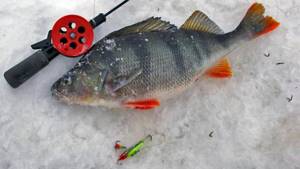
If we talk about the tactics of catching perch on a balance beam, then in general, it can be described in a few words - the size of the catch is directly dependent on the number of holes drilled. Active search for fish is the key to success in catching perch on a balance beam. If we assume that the balancer attracts perch by collecting fish over an area within a radius of up to 3 meters, holes should be drilled 5-6 meters from each other, stopping in interesting places. If an edge, snag or other anomaly is found at the bottom, you should drill more thoroughly nearby.
The noise of an ice drill can attract perch
We should not forget about the noise on the ice and the light in the holes, especially in shallow water. It is better to immediately prepare a series of holes so as not to disturb the fish with constant drilling, although this is not so important for perch. The holes should be darkened by sprinkling them with slush or snow.
Perch game on balance beam
Playing with a balance is called wiring. How willingly the perch will grab the balancer depends on the wiring. Underwater filming often shows that the perch is simply looking at the balance beam, nothing more. The reason is an incorrectly selected bait, and no game at all. Most often, the second thing happens - the perch is not motivated enough to grab the balancer.
Let's consider several options for working perch retrieves, but first let us remind you that most of the perch bites on the balancer occur during a pause. When starting to catch perch on a balance beam, it is better to “wait it out” than “not wait,” and after catching several perches, it will be clear how long the pause should be.
Pause is a key moment in balancing game
So, we lowered the balancer to the bottom, raised it a few centimeters, and began the game.
Balance game options:
- A short, up to 50 cm, quick jerk of the bait and immediately return to its original position. Pause. Repeat monotonously in a loop several times.
- A relatively smooth rise of the balancer by one meter or so with a slight delay at the top point of the retrieve and a smooth return of the bait to the starting point accompanied by swinging the balancer with the hand.
- Lightly hit the bottom with the balancer several times, lift it a few centimeters and sharply wave the fishing rod, raising the balancer by 30-50 cm, and sharply drop the bait to its original position at the bottom.
- Raise by 30 - 40 cm, pause 2 - 3 seconds, another rise by 20 - 30 cm, pause 5 - 10 seconds and sharply reset to the starting position. Double lift can be used with other jerk and pause options.
- Between other types of postings, we use the principle of jigs - twitching and swaying with slow movement and stops vertically.
- Raising the balancer from the bottom to the ice with short, quick jerks of 20–30 cm and a pause of 5–10 seconds. Such wiring often works during the period of last ice. At the same time, the perch reacts to the balancer already in the upper layers of the water, almost at the ice. If there is no bite from the perch, the balancer slowly returns with swaying movements.
In the process of catching perch in winter on a balance beam, try to understand at what moment and after what the perch bite occurs. If you have identified this element, increase the emphasis on it in an attempt to improve the result, making the game of the balancer more attractive to the perch.
Homemade balancer
A certain group of fishermen is keen on producing fishing lures on their own, and in the winter road set, the most catchy balancers for perch are made with their own hands. Homemade products imitate brand products in the craftsman’s own interpretation, who endows the spinner with a couple of unique qualities that help better attract predators. There are a number of simple production methods that, if desired, you can try at home and get results. As a material, use low-melting metal (lead and tin), wood, plastics and even metal sheets of small thickness (tin). Let's consider two options for making homemade products.
Casting

Gypsum mold for casting material
Balancers for perch in winter can be cast into a pre-made matrix of plaster or clay. To do this, you will need to make two mirror prints of the simulator prototype in soft material, which will then become a solid product. Before pouring, hooks are inserted into the matrix, mounted on a frame, which will serve as fasteners for the tee and mounting eye. Casting is done with molten lead or tin. The matrix is arranged with a sprue and holes for the release of air squeezed out of the cavity. After the metal has solidified, the workpiece is removed from the fixture and brought to the desired shape by grinding. And then they are retrofitted with a tee, plastic blades and painted in a promising color.
Surfacing on metal stampings
Another way to make your own balancer for perch in winter is based on the stamping production method. To do this, a stamp is made from steel, with which half of the future balancer is squeezed into a piece of tin. A whole product is assembled from the two halves, first fusing the tin material needed for playing and balancing the bait into the inner part, installing hooks and fasteners. The assembled homemade product is painted with waterproof paints and equipped with wings and a tee.
Decoy upgrade
Often, tuning or upgrading the factory bait helps catch perch on a balance beam. Modernization is done by trimming or enlarging the wings of the simulator, which will make the game either sharper, in the first case, or smoother, which will happen in the second.
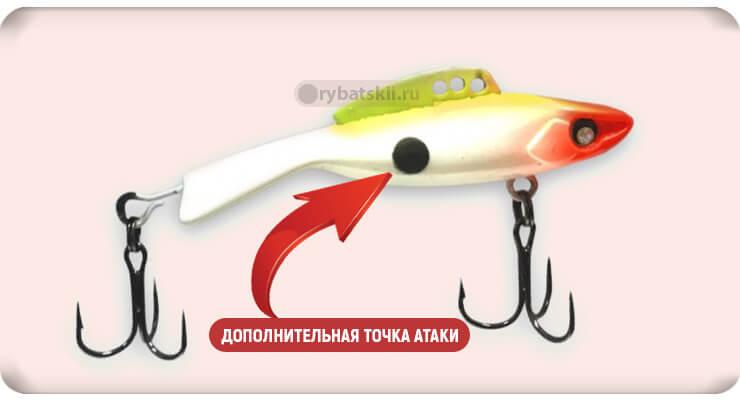
The catchability is increased by an additional point of attack, marked with a marker on the body of the fishing tool or mounted in the form of a bright and fluorescent bead on the tee. Painting the spoon with light-accumulating paint can improve the results of fishing at great depths. Perch reacts faster to flashing stimuli in the dark.
This type of winter perch fishing is increasingly gaining popularity due to the simplicity of the configuration of the fishing rod for the balancer. Therefore, mastering the technique will by no means provide the chances of promising fishing throughout the winter. The simplicity of the fishing technique will be an incentive for every novice angler to master winter trolling, delighting with the inevitable results.
Tackle for catching perch in winter
Catching perch in winter is a very exciting activity. There are several types of ice fishing:
- For the spinner.
- Live bait.
- On the jig.
- To the balancer.
For all types of such ice hunting, except for live bait fishing, you will need a short fishing rod for winter fishing with a small reel. When fishing with live bait, girders are used.
Any ice fishing requires certain physical costs to prepare fishing sites. Most often, winter fishing begins with choosing a drill and a scoop to clean the holes from small fragments of ice and snow. And of course, purchases of spinners, jigs and balancers for winter perch fishing.
Fishing equipment should also include a special fishing box. It stores basic equipment, gear, bait and fishing gear. The box itself serves as a seat for the fisherman. However, you can take a small folding chair with you when fishing. After all, during winter fishing you have to walk a lot from one hole to another.

